
I was sitting at my desk, looking out of the shop window into the woods, and wondering exactly what kind of big, bushy, snarling mammal had just dragged a wild turkey down into a hole under a nearby birch tree. Living in Maine, home to Stephen King, can be interesting. I couldn’t see down into the hole, but I could see enough. There was an explosion of feathers, some brief but desperate gooble-goobling, a thick red spattering of blood, and what I could only describe as a protracted muffled belch. It was somewhere in the midst of this commotion, I decided it might be time for a kick-ass thirty magnum project. I like working with big guns. It’s like listening to Lynyrd Skynyrd’s “Sweet Home Alabama”…twice.
Avoiding extremes…
 For as much as I have fun with cartridge like the .500 Jeffery and the .17-357 RG, I accept there are times when 8,000 ft-lbs of muzzle energy may be a bit much and there are times when bullets can get so small that shot game looks more confused than injured. Subsequently, over the past couple of years, I’ve done a pretty good job of paring down my selection of hunting rifles. This focus has allowed me to work on my field shooting proficiency and to develop some very good hunting handloads.
For as much as I have fun with cartridge like the .500 Jeffery and the .17-357 RG, I accept there are times when 8,000 ft-lbs of muzzle energy may be a bit much and there are times when bullets can get so small that shot game looks more confused than injured. Subsequently, over the past couple of years, I’ve done a pretty good job of paring down my selection of hunting rifles. This focus has allowed me to work on my field shooting proficiency and to develop some very good hunting handloads.
A very light and compact 7mm-08 Remington Mountain Rifle took the place of firearms chambered for the .243 Winchester, .30-30 WCF and .45-70 Gov’t. A 270 WSM replaced all of my .257″ through 7mm magnum rifles. This commitment to a couple of cartridges allowed me to make much better choices in scopes and shooting accessories and to come up with some very well balanced combinations.
Now I needed to select one more rifle, a nudge up from these firearms, that would cover the largest North American game, something that would work well for close up and at extended range shots. Unfortunately, everything I owned was either an overkill or not able to cover long range shooting. The .416 Weatherby would be an example of the first case, the 325 WSM would be an example of the second. It was time for a well thought out .308″ gun.
Good, better and best… The .300 Ultra Mag
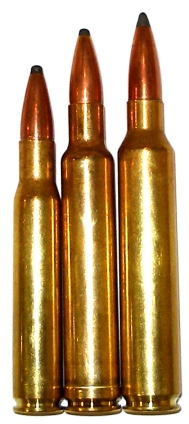 The .30-06 Springfield is a terrific cartridge. If I was going to carry one rifle, that would be the cartridge, however, for my purposes I needed something with a little more thump and range. The original .300 Winchester Magnum has never appealed to me; too little real world gain over the .30-06. The .300 Weatherby could have been my cartridge choice, however, my enthusiasm for the cartridge does not carry through to the current Weatherby Mark V rifle.
The .30-06 Springfield is a terrific cartridge. If I was going to carry one rifle, that would be the cartridge, however, for my purposes I needed something with a little more thump and range. The original .300 Winchester Magnum has never appealed to me; too little real world gain over the .30-06. The .300 Weatherby could have been my cartridge choice, however, my enthusiasm for the cartridge does not carry through to the current Weatherby Mark V rifle.
Each year, more and more Weatherby innovation seems to be displaced by process and technology purchased from outside companies. About the only thing remaining from the company’s early philosophy of “Weatherby – Tomorrow’s Rifles Today” is the big price tag. Quality and finish have been on the decline in recent years, and there hasn’t been a cartridge introduction since 1999 with the .338-378 Weatherby.
The Vanguard, Weatherby’s price leader, is an OEM version of the low cost Japanese Howa, a firearm that has been around for many years, sold in a number of derivative forms and under a number of brand names. In this case, the Howa gets a Weatherby profile stock and bolt shroud to justify the use of the Weatherby name. Of greater consequence, a Vanguard won’t deliver Mark V performance, not as an issue of inferior quality, but rather because Weatherby insists on producing Vanguards chambered for Weatherby Magnum cartridges with barrels 2″ shorter than their more expensive Mark V counterpart.
Weatherby leaves a potential customer with the options of paying an excessive price and getting the real deal Mark V, or paying a more reasonable price and getting a Weatherby in name only. Insult to injury, there is a substantial extra charge for accurate versions of either. I chose option number three, a Remington Model 700 CDL .300 Ultra Mag – more performance than the Weatherby, at a consumer friendly price and accuracy is included with every rifle.
A little…OK, a lot of Ultra Mag rehash
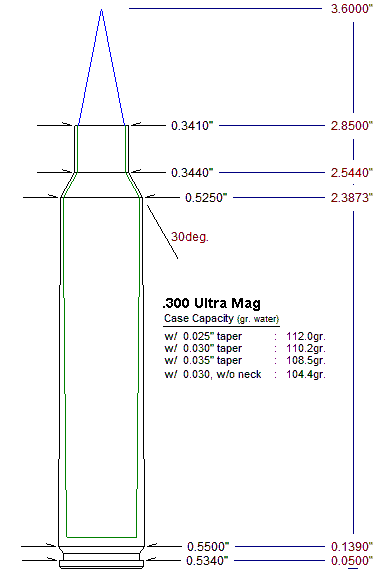 The .300 Remington Ultra Mag has been tagged as being too long, too large and too extreme of a chamber. In reality, it is about the same length as any full length H&H based magnum, but it does have approximately 20% greater capacity. The increase is the result of a 0.040″ taller shoulder and a larger case body diameter. The belt diameter of an H&H magnum is 0.531″, but the actual body diameter at the case head is only 0.512″. The beltless Ultra Mag body diameter is 0.550″.
The .300 Remington Ultra Mag has been tagged as being too long, too large and too extreme of a chamber. In reality, it is about the same length as any full length H&H based magnum, but it does have approximately 20% greater capacity. The increase is the result of a 0.040″ taller shoulder and a larger case body diameter. The belt diameter of an H&H magnum is 0.531″, but the actual body diameter at the case head is only 0.512″. The beltless Ultra Mag body diameter is 0.550″.
A case belt does not actually increase case strength, nor does brass do much to contain pressure. Brass is, more or less, a really good gasket between case pressure and a firearm’s breech and chamber walls. It was added to magnum cases as a headspace reference point in the early 1900’s. This was a time when manufacturers’ ability to hold chamber dimensional tolerances was iffy and cartridges had long tapering shoulders that were not the best for establishing headspace. With today’s manufacturing precision and sharper shoulder angles, the belt is superfluous.
The Ultra Mag converts chamber space that would normally be filled with excess brass into additional room for powder. Unlike short magnums that make powder selection a challenge, where most popular types are too fast or too slow, the Ultra Mag’s112 grains of case capacity seems just about right. Popular slow powder types from all of the leading producers produce case full loads that extract the potential of the cartridge at virtually every bullet weight. Without the belt producing part of the manufacturing process, brass is relatively inexpensive within the context of magnum cartridges and the .308″ bullet selection is second to none. Which brings me to the next point and the real reasons I felt it was finally time to move to a high performance .308″ gun.
Bullets that make the Ultra Mag work as intended…
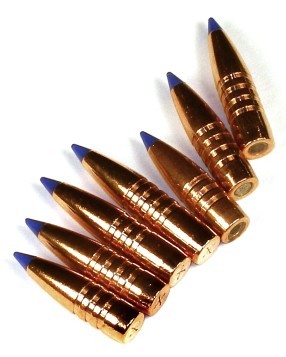 The “$2 Bullet Analyzer” and “Metric Rehab – Handloads for the 30-06 Springfield” projects led me to Barnes TTSX and MRX bullets. They fly straight, hold up with controlled expansion and recovered bullets retain close to original weight at almost any range. Both of these Barnes products seem to function properly over a much wider velocity range than conventional jacketed lead bullets where fast magnums can really challenge a bullet’s design.
The “$2 Bullet Analyzer” and “Metric Rehab – Handloads for the 30-06 Springfield” projects led me to Barnes TTSX and MRX bullets. They fly straight, hold up with controlled expansion and recovered bullets retain close to original weight at almost any range. Both of these Barnes products seem to function properly over a much wider velocity range than conventional jacketed lead bullets where fast magnums can really challenge a bullet’s design.
Even at .30-06 Springfield performance levels, basic jacketed product from Nosler, Speer, Sierra and Woodleigh often demonstrated less than satisfactory results. Impact inside 50 yards sometimes converted jacketed lead bullets to shards of copper and lead. At 200-250 yards expansion was sometimes marginal. Nosler Partition bullets, at very near distance, tended to be recovered as a whole shank and a blown away nose. Hornady did better, but shed a lot of weight inside 100 yards. The .300 Ultra Mag was going to be pushed over a wide variety of distances and with all useful hunting bullet weights.
The Barnes line has really evolved over the years to keep pace with cartridge and firearm development. Their basic TTSX triple shock is very accurate and expands reliably. The MRX Silvex core is a real piece of design work. While I am not privy to Barnes’ definition of their proprietary Silvex, Silvex is typically defined as containing a non-toxic combination of heavier than lead tungsten, tin and bismuth. Both center of gravity and center of pressure are shifted aft to the shank, which increases a bullet’s tendency to remain at a neutral angle and stabile. That’s why the MRX is capable of very tight groups at extended ranges. Because the bullet is made for long range applications, the nose cavity is cut differently to promote full expansion, even way out there where velocity has diminished. This subject will be covered extensively in Part II of this series.
Improving the product since 1816 and it shows…
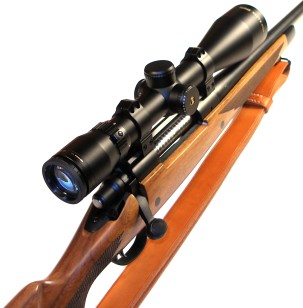
| Model | Remington 700 CDL |
| Cartridge | .300 Ultra Mag |
| Weight | 7 lbs 10 oz |
| Overall Length | 46″ |
| Barrel Length | 26″ |
| Magazine Capacity | 3 |
| Stock – Drop at Comb | 1⅛” |
| Stock – Drop at Heel | 1⅜” |
| Stock – Pull | 13½” |
The rifle selected for the project is a Remington Model 700 CDL Ultra Mag, walnut stocked with a matte blue finish. It is more than a just a nice looking rifle. The lines are classic and pleasing. It isn’t a lightweight, but then its well balanced modest heft puts recoil in the neighborhood of 35 ft-lbs and dampens that with a truly comfortable R3 recoil pad.

I broke the CDL down to its major assemblies, hopefully on a temporary basis, to clean and have a look around in there. The outside of the gun was flawless, both metal and wood, and the parts uncovered in disassembly were just as nice; perfect metal finish and clean machine work and castings. I’ve grown accustom to finding bare metal spots, rough welds and finishes and lots of plastic parts on other brands, so this was a pleasant surprise.
The Remington receiver is cylindrical; no torque twisted flat surfaces or unpredictably stressed wood to metal contact that could have an adverse affect on accuracy. The chamber is surrounded by barrel steel and receiver and the case head is surrounded by the bolt on lock up; three rings of steel. I think a lot of folks don’t realize how strong these actions are. A Model 700 barrel shank is 0.062″ greater in diameter than a Ruger, identical to the barrel shank of a big magnum Weatherby Mark V.
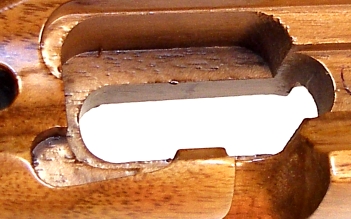 Clearance cuts are clean, surfaces square and uniformly contoured, everything is sealed and smoothly finished even though only the cradling radius supports the action. In other brands, it is very common to find bare wood, chunks missing out of supporting surfaces and uneven metal to wood contact. The magnum CDL has a large surface area vertical recoil lug as well as hardwood plugged, double cross bolts to provide additional support at critical recoil absorbing points.
Clearance cuts are clean, surfaces square and uniformly contoured, everything is sealed and smoothly finished even though only the cradling radius supports the action. In other brands, it is very common to find bare wood, chunks missing out of supporting surfaces and uneven metal to wood contact. The magnum CDL has a large surface area vertical recoil lug as well as hardwood plugged, double cross bolts to provide additional support at critical recoil absorbing points.
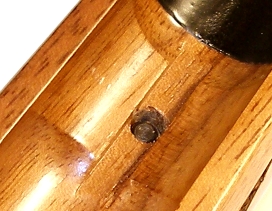 The barrel floats in the forearm with the exception of contact with the two raised pads in the barrel channel, just behind the forearm tip. The barrel channel is completely finished, sealed and smooth. The benefit of this attention to detail is the assurance that the stock’s moisture content will be constant, rendering it dimensionally stable.
The barrel floats in the forearm with the exception of contact with the two raised pads in the barrel channel, just behind the forearm tip. The barrel channel is completely finished, sealed and smooth. The benefit of this attention to detail is the assurance that the stock’s moisture content will be constant, rendering it dimensionally stable.
Touches like those I’ve just mentioned use to be check list items on a custom gunsmith’s guide to assure firearm accuracy, and now they appear in every Remington production rifle. They take a little more time, they cost a little bit more but, ultimately, they make for a firearm worth owning.
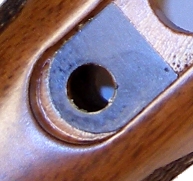 Sometimes the most interesting design touches are the simplest. I don’t know what was in the mind of the designer who decided to add this 0.025″ poly shim stock under the trigger guard , but I can hazard a guess. The shims provide large pressure pad surfaces near the fasteners and lift the long run of the trigger guard between fasteners off of the stock inletting. This would assure maximum vertical clamping force while eliminating torsional distortion of the aluminum guard caused by out of parallel surfaces. My alternate theory is that the poly shims prevent the guard from cutting into the wood. My alternate, alternate theory is that it would be really nice to have access to the engineering staff and be able to ask all sorts of questions.
Sometimes the most interesting design touches are the simplest. I don’t know what was in the mind of the designer who decided to add this 0.025″ poly shim stock under the trigger guard , but I can hazard a guess. The shims provide large pressure pad surfaces near the fasteners and lift the long run of the trigger guard between fasteners off of the stock inletting. This would assure maximum vertical clamping force while eliminating torsional distortion of the aluminum guard caused by out of parallel surfaces. My alternate theory is that the poly shims prevent the guard from cutting into the wood. My alternate, alternate theory is that it would be really nice to have access to the engineering staff and be able to ask all sorts of questions.
The bottom metal compliments the rest of the rifle; clean, light aluminum castings for the hinged floor plate and guard, steel latch works, spring and follower. The hardware is Allen head which I always appreciate as they are about the only type that allows me to properly tighten the screw without chewing them up. Torque value for the wood stock Remington is 30 – 35 inch pounds and, yes, I really do use a torque wrench to secure these. Accuracy is better and they are less prone to shoot loose.

The Remington has a two position safety, safe and fire, and a X-Mark Pro trigger. The trigger have no creep, very smooth and hard friction surfaces, they break very cleanly, and the pull is uniform even after extensive use. This one broke at 4 ½ lbs which is great for me. The X-Mark Pro is not an owner adjustable trigger and the procedure for gunsmith adjustment is different from a standard Model 700. Personally, I only go to work on a trigger when they need help and this one is perfect as produced.
The dog leg bolt handle and flattened knob make for some extra room in clearing large diameter scope eyepieces. The push feed Remington action is smooth in cycling, devoid of rough spots or annoying drag so common in other designs such as Mauser type actions.
It helps to see the target…
As I mentioned earlier, a more careful selection of cartridges and rifles permitted better selection of scopes and other accessories. This is an example of being able to select a scope that is optimal for a cartridge/rifle combination, a Bushnell Elite 6500. The scope has an exceptionally large magnification range, from an up close 2.5x with a huge field of view to cross canyon and prairie shooting 16x. The 30mm tube and big 50mm objective make for a bright sharp image and the mechanical design makes for stay put settings and a scope that is impervious to foul weather. The scope is covered in detail elsewhere on Real Guns, but I did want to note that after over a hundred rounds of full tilt loads, the scope never moved out of adjustment. The Mil Dot reticle is perfect for this application.
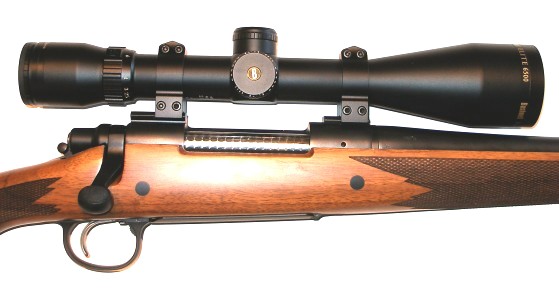
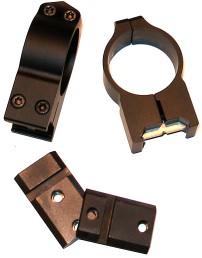 Between the Remington and Bushnell Elite’s geometry, the large objective lens scope hugs the gun’s barrel with medium height mounts, but still has plenty of bolt handle cycling clearance. Aesthetically, the finish and markings on the Bushnell scope compliment the Remington CDL.
Between the Remington and Bushnell Elite’s geometry, the large objective lens scope hugs the gun’s barrel with medium height mounts, but still has plenty of bolt handle cycling clearance. Aesthetically, the finish and markings on the Bushnell scope compliment the Remington CDL.
Steel Warne Maxima rings and bases were purchased fromBrownells for $32. They are really tough, finely finished and soundly designed. A scope mounted with these will stay put under heavy recoil and there is the added bonus of a nice scope not being chewed up by rough and uneven clamping surfaces. Four socket head cap screws hold each ring set together and a hardened recoil control key locks the ring to the steel base to prevent fore and aft movement. The rings are wider than typical for an increased contact surface area. Warne also produces quick disconnect rings and bases and ring sets to fit proprietary mount systems such as Ruger, Sako, CZ, etc.
The return of the Latiiiigo…
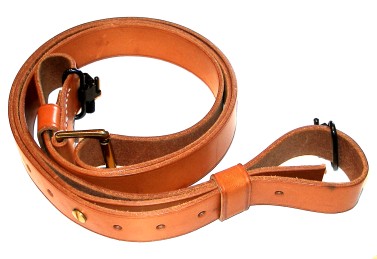
I like rifle slings. They make carry comfortable and they provide excellent support in almost any shooting position for steady, well placed shots.Brownells‘ Quick Set Latigo sling has made it onto a number of my rifles and this Ultra Mag combination seemed like a great place for another. At $69, it is a quality piece of leather and I don’t have to worry about finding a steady rest in the field or carry shooting sticks. The Latigo sling in particularly good because it converts from carry sling to shooting sling quickly.
In the words of John Lee Hooker – Boom, boom, boom boom
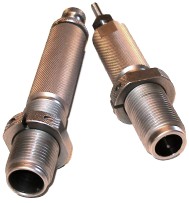
Every major die manufacturer makes several versions of dies for the .300 Ultra Mag. Some are basic, some have micrometer adjustment, then there are neck sizers and full length sizers. For this project, a set of Hornady New Dimension dies were selected…for a number of reasons. I like the threaded collet shaft on the decapper. It stays put and never gets tugged out when pulling the case from the die. I also like the tapered expander, it makes for smoother press operation. I also like the floating seater die that does a great job of centering the bullet in the case mouth. I also like the small diameter lock rings that allow the dies to be installed and adjusted even with small circle turret heads. Lastly, I like the quality of finish and the dimensions held in sizing. They are not very fancy, but they certainly take care of all of the fundamentals.
Summary
This is working out better than I anticipated, and I already had some relatively high expectations. I like the rifle and scope combinations and they passed the visitors check. In this case, the Remington rifle and Bushnell scope combination where leaned up against the wall with three other rifles of different manufacturer with different scopes, each an attractive firearm in its own right. Then I asked visitors which they preferred. This area is loaded with hunters and shooters and folks who take a lot of pride in their firearms. Everyone picked up the Ultra Mag. Next and last, handload work up and shooting assessment.

Email Notification